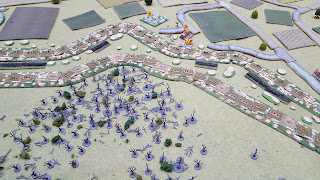The terrain lay out, mainly using club terrain with some of Will's snake rail fencing and buildings. Rebs come on from the right and need to cross the stream to get to grips with the Union deployed between the road and the stream. Union reserves come on from the left at a random location determined by dice roll on the roads or through the woods.
The Reb hordes come out of the forest and push towards the stream from the top edge of the photo. Union defenders are deployed in a thin blue line. The line is anchored in the centre on a rifle regiment occupying a farm building just out of sight off the bottom of the photo.
A couple of southern gentlemen, Will and Ian.
Well, once we got started, it took three turns to conclude. The Rebs attempted to rush across the stream and generally managed to fail command rolls, coming on in a piecemeal fashion. Meanwhile, the Union rolled for each of three brigades to come on, needing 4+, and they succeeded in bringing on a brigade per turn, randomly spread across the back of the Union line. Will's Rebs did contact the Union line, but finished up with a broken brigade and various whipped units. The Union front line was similarly shaken but holding firm, for now. However, behind the Union front line were three fresh brigades deployed in double lines, which the southern gentlemen didn't relish attacking, so decided to slink away into the undergrowth.
Taken from the Union left, the front line shows the pounding it has taken with lots of hit dice and shaken or disordered markers (yellow/red respectively). The Reb right is in an even poorer state with some regiments routed or whipped and one brigade broken. The Rebs on their left flank took too long to get through the woods, but were by the end making a nuisance of themselves shooting under cover from the edge of the trees.
Three very similar shots, highlighting the superb figures from Will's collection, which is most excellent.
We have only played the scenario once, but it seemed to us that there was too good a chance for the Union to bring on reserves. Three brigades with an evens chance of each coming on means only a 1 in 8 chance of not getting any reserves at all on turn 1. With the odds in favour of a steady Union build up, if the Rebs don't get to grips with the Union line in the first couple of turns, it will all be over for them very quickly. It was lots of fun for me as the Union player, but I suspect less so for the southern gentlemen.
Looking forward to the next ACW outing, having "seen the elephant".
Thanks for looking.











































































